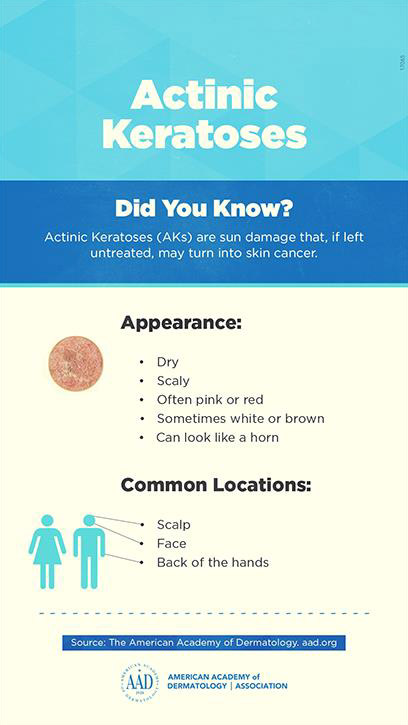Actinic Keratosis: Diagnosis and Treatment
Diagnosing Actinic Keratosis:

Dermatologists perform a skin evaluation to determine if actinic keratosis (AK) is present on the skin.
If your dermatologist suspects there is an AK present, then they may perform a skin biopsy that will be sent to a laboratory to be diagnosed, cryosurgery or other at home treatments may be advised.
These AK’s are considered pre-cancer and if caught early can prevent skin cancer with the proper treatment.
Treating Actinic Keratosis:
There are many treatments for AKs. Some treatments your dermatologist can perform in the office. Other treatments you will use at home. The goal of treatment is to destroy the AKs. Some patients receive more than one type of treatment. Treatments for AKs include:
In-office procedures
Cryotherapy:
Destroys visible AKs by freezing them. The treated skin often blisters and peels off within a few days to a few weeks. This is the most common treatment. When the skin heals, you may see a small white mark.
Curettage:
Your dermatologist carefully removes a visible AK with an instrument called a curette. After curettage, your dermatologist may use electrosurgery to remove more damaged tissue. Electrosurgery cauterizes (burns) the skin. New healthier skin will appear.
Chemical peel:
This is a medical chemical peel. You cannot get this peel at a salon or from a kit sold for at-home use. This strong peel destroys the top layers of skin. The treated area will be inflamed and sore, but healthy new skin will replace it.
Prescription medicine
Your dermatologist may prescribe a medicine that you can use at home to treat AKs. Medicines that dermatologists prescribe include:
5-fluorouracil (5-FU) cream:
This is chemotherapy that you apply to the skin. It causes temporary redness and crusting. Patients typically apply 5-FU twice daily for 2 to 4 weeks. A person who has lots of damaged skin may need to use 5-FU longer. 5-FU causes sun-damaged areas to become raw and irritated. As the skin heals, healthy skin appears. Another treatment such as cryotherapy may be necessary to treat thick AKs.
Diclofenac sodium gel:
This is a non-greasy gel. You apply it to skin with lots of AKs. Patients apply the medicine twice a day for about 2 to 3 months. During this time, you must protect your skin from the sun. You will see the best results about 30 days after you stop applying the gel. Some AKs can remain. Your dermatologist will treat these, often with cryotherapy.
Imiquimod cream:
This cream helps boost your body’s immune system so that your body can get rid of the diseased skin cells. You will apply this cream to your skin as directed by your dermatologist. Most patients apply imiquimod for several weeks. Imiquimod causes the skin to redden and swell. After you stop using the medicine, the skin heals.
Ingenol mebutate gel:
This gel works in two ways. It boosts the body’s immune system. It also is a type of chemotherapy for the skin. One formula is used to treat AKs on the head and scalp and is applied for 3 days in a row. The other formula treats AKs on the legs, arms, and torso. Patients apply this formula for 2 days in a row. Both formulas can cause rapid redness and swelling. As the skin heals, the redness and swelling clear.
Outcome
Some people get only a few AKs. These AKs often clear with treatment.
If you have many AKs, you need to be under a dermatologist’s care. AKs form in skin that has been badly damaged by the sun or indoor tanning. This damage often causes people to get new AKs for life. Left untreated, AKs may turn into squamous cell carcinoma, a type of skin cancer. With frequent checkups, this skin cancer can be found early and removed. When found early and treated, most skin cancers can be cured.
Researchers continue to look for new treatments for AKs. No one treatment works on all AKs.
Your dermatologist will tell you how often you should return for checkups. Some patients need a checkup once every 8 to 12 weeks. Others return for a checkup 1 or 2 times per year.
You should keep every appointment. If skin cancer develops, the sooner it is detected and removed, the better the outcome.
(Source and more info )
